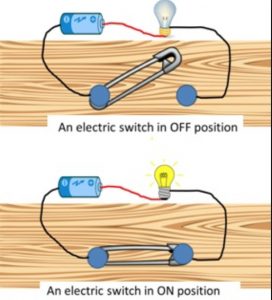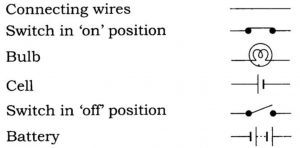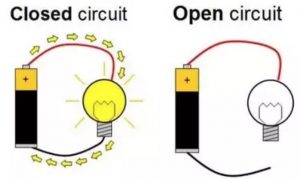Question 1 What is an electric circuit? Draw an open and closed circuit?
Question 2 What is meant by a battery? How will you arrange two cells to make a battery?
Question 3 Give the names and symbols for common electrical components?
Question 4 Draw a circuit diagram with an open and closed switch?
Question 5 What are storage cells?
Contents
Electric Current
The flow of electricity through a conductor (such as a metal wire) is called electric current . Electricity (or electric current) is useful because it can run many appliances (or machines) in our day to day life which make our work easier. The electric bulb, tube lights, radio, television, stereo systems, refrigerator, washing machine, fans, coolers, air conditioners, computers, electric iron, electric kettle, room heater, electric oven, mixer and grinder, geyser, water pumps and trains all work with electricity (or electric current).
Electricity is produced at power stations (also known as power plants). The big electric generators at power stations produce electricity. From the power stations, electricity is brought to our homes through thick wires atop tall electric poles. Underground electric wires (called cables) are also used to bring electricity into our homes.
Though electricity is very useful but it can also be very dangerous. If electric wires and electrical appliances are handled carelessly, then a person can get an electric shock which may cause severe burns and even death. Improper handling of electricity can also cause fires.
We should never use electricity (or electric current) from electric power supply line (which is called mains electricity) through sockets in our home or school, or that produced by portable generators or inverters, for performing science experiments because it is very unsafe to do so. It may give us an electric shock, which may be dangerous.
We can use an electric cell to obtain electricity (or electric current) that is safe for performing science experiments. An electric cell provides much less electricity than that provided by the electric supply line.
For example: A single electric cell usually provides only 1.5 volt of electricity whereas the electricity from the power station which we get in our homes is at a very high voltage of 220 volts. To obtain electricity (or electric current) from a cell or battery, we have to connect it into a circuit.
Electric current is actually a flow of charged particles called electrons in a conductor (such as a metal wire).
Electric Circuit
A cell or battery is a source of electric current.
A continuous conducting path (consisting of wires, bulb, switch, etc.) between the two terminals of a cell or battery along which an electric current flows, is called a circuit.
(1) A cell have a positive terminal(+) and a negative terminal (-)
(2) The positive terminal of the cell is connected to one end of the switch with a piece of copper wire.
(3) The other end of switch is connected to one end of bulb holder with another piece of copper wire.
(4) The negative terminal of the cell is connected directly to the other end of bulb holder with a copper wire.
If we open the switch so that it comes in the ‘off position, then a gap is created between the two ends of the copper wire (or connecting wire). Due to this, one terminal of the cell gets disconnected from the bulb and hence the current stops flowing in the circuit. Thus, when the switch is open (or in off position), the circuit breaks and no current flows through the bulb. The bulb stops glowing.
When the switch in a circuit is ‘closed’, then the switch is said to be in the on position. When the switch is in on position , the circuit gets complete and hence a current flows in this. This electric current makes the bulb light up.
And when the switch in a circuit is ‘open’, then the switch is said to be in the ‘off’ position. In an electric circuit, a bulb lights up (or glows) only when the switch is in the ‘on’ position and the electric circuit is complete. The bulb does not light up (or does not glow) when the switch is in the “off position and the electric circuit breaks.
Sometimes the bulb does not light up (or glow) even when the switch is in the ‘on position (or closed). This can happen only if the bulb gets fused (and its filament breaks).In an electric bulb there is a thin wire called filament which becomes white-hot and glows when electric current passes through it. When the bulb gets fused, then its filament breaks. The filament of bulb is a part of the electric circuit. So, when the filament of bulb breaks, then the electric circuit also breaks. Under these conditions, the bulb will not light up (or glow) even if the switch is in the ‘on position (or closed).
A switch can be connected anywhere in a circuit. When we bring the switch of such a circuit in the ‘on position, then electric current will flow instantly through the whole circuit due to which all the bulbs will light up (or glow) together at once. When the switch is in the ‘off position, then no current can flow in any part of the circuit and hence no bulb can light up (or glow).
Symbols for Electrical Components (or Circuit Symbols)
In electric circuits we have to show a cell or battery, switch, bulb (or lamp) and connecting wires.
(1) The symbol of a cell consists of two parallel lines, one thin and long, and the other thick and short. The long and thin line represents the positive terminal of the cell whereas the short and thick line represents the negative terminal of the cell.
(2) The symbol of battery consists of two cells joined together. In the symbol for a battery, the positive terminal of one cell is joined to the negative terminal of the other cell. Thus, the symbol for representing a battery of three cells will have three pairs of long and short parallel lines connected to one another.
(3) The symbol of electric bulb consists of a circle having a semi-circle inside it. The semi-circle represents the filament of the bulb. The switch is a device which is used to ‘make’ or ‘break’ an electric circuit.
(4) The symbol of an open switch and closed switch is shown in figure. A switch is sometimes also called a key.
(5) The connecting wires (which are used to connect the various components of a circuit like cell, switch, bulb, etc.) are represented just by drawing straight lines. These straight lines can be horizontal as well as vertical.
It is very convenient to represent various electrical components (such as a cell, battery, bulb, switch and connecting wires) by symbols.By using these symbols, electric circuits can be represented conveniently by drawing their circuit diagrams.
Circuit Diagrams
A diagram which tells us how the various components in a circuit have been connected by using the electrical symbols of the components, is called a circuit diagram. So, we usually represent an electric circuit by its circuit diagram.
The circuit is complete (due to closed switch) means there is no gap due to which current flows in this circuit and the bulb lights up.
The circuit is broken (due to a gap because of open switch), so no current flows in this circuit and bulb does not glow.
Battery
The electric cell is a common source of electric current to run a number of devices in our everyday life.
For example: electric cells are used in torches, radios, TV remote controls, cassette players, electric clocks and watches, toys and laboratory experiments. A single electric cell gives 1.5 volts of electricity.
The higher voltage can be obtained by combining a number of cells in series. When the positive terminal of one cell is joined with the negative terminal of the other cell, then the cells are said to be joined in series.
A group of cells joined in series is called a battery.
A battery of two cells gives 1.5 x2 =3.0 volts , a battery of 3 cells gives 1.5 x3=4.5 volts, a battery of 4 cells gives 1.5x 4=6.0 volts of electricity. In a torch, usually two cells are used. And in a radio, usually four cells are used together.
When joining two (or more) cells to make a battery, the positive terminal of one cell is always kept in contact with the negative terminal of the other cell. The positive terminal of a cell is the brass cap and the negative terminal is the bottom of the zinc container. So, the cells are joined in such a way that the brass cap of one cell touches the zinc bottom of the other cell.
(1) If we combine two cells by keeping the positive terminal of one cell in contact with the positive terminal of the other cell, then the battery obtained will not work. It will not give any current when connected in a circuit.
(2) If we combine two cells by keeping the negative terminal of one cell in contact with the negative terminal of the other cell, even then the battery will not work.
In a torch, the cells are placed one after the other (in one straight line).In many devices, the cells are not placed one after the other, the two cells are placed side by side (parallel to each other).
For example: In a TV remote control, the two cells are placed side by side. When the two cells are placed side by side, they are joined to make a battery. In this case, the positive terminal of one cell cannot be in touch with the negative terminal of the other cell. So, the positive terminal of one cell is joined to the negative terminal of the other cell by a piece of wire.
When the two cells are to be placed side by side in an appliance, then there is a special arrangement to connect the positive terminal of one cell to the negative terminal of the other cell inside its battery compartment (or cell holder). There is usually a thick wire or a metal strip in the battery compartment of the appliance which connects the positive terminal of one cell to the negative terminal of the other cell automatically when the cells are placed inside it. In order to help us to place the cells correctly in the battery compartment, the symbols plus (+) and minus (-) are printed in the two sides of the battery compartment.
The devices such as torches, radios, TV remote controls and toys use batteries (made of two or more cells).
Storage Cells
The batteries used in cars, buses, trucks, tractors and inverters are made up of cells. The cells of these batteries are different from the ordinary cells which we use in torches. These cells are called storage cells.
A car battery has 6 cells joined to one another in series. A special feature of car battery is that its cells can be recharged. Ordinary cells, cannot be recharged. Once exhausted, they have to be thrown away.



Thanks for the helpful teaching.